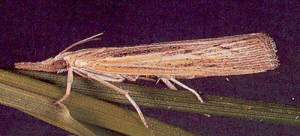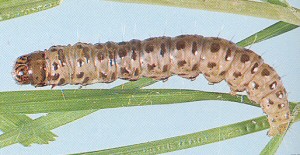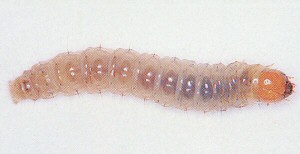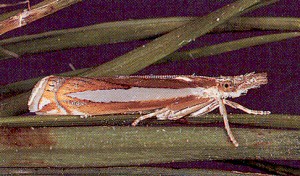Sod webworms
 Scientific Name
Scientific Name
Crambus spp.
Host
With rare exceptions, sod webworms feed primarily on plants of the grass family. Turfgrasses most commonly recorded as hosts include Kentucky bluegrass, perennial ryegrass, fine fescue, and bentgrass. Records of damage to warm-season grasses are relatively few; however, some species will damage bermudagrass and zoysiagrass.
Symptoms
 Young larvae feed only on the surface layers of leaves and stems. The first evidence
of damage to a normally growing lawn may be small patches of leaves that are yellow
to brown during the summer. Larger larvae cut off grass blades just above the thatch
line, pull them into their tunnels, and eat them. The injury appears as small brown
patches of closely cropped grass. If many larvae are present, the patches run together
to form large, irregular brown patches. The presence of webworms under a drought condition
constitutes the most serious situation for potentially serious turfgrass damage. Not
only can the dormancy of the grass restrict the manifestation of early feeding symptoms,
but all too often the dead turf does not become evident until fall rains revitalize
the normal turf.
Young larvae feed only on the surface layers of leaves and stems. The first evidence
of damage to a normally growing lawn may be small patches of leaves that are yellow
to brown during the summer. Larger larvae cut off grass blades just above the thatch
line, pull them into their tunnels, and eat them. The injury appears as small brown
patches of closely cropped grass. If many larvae are present, the patches run together
to form large, irregular brown patches. The presence of webworms under a drought condition
constitutes the most serious situation for potentially serious turfgrass damage. Not
only can the dormancy of the grass restrict the manifestation of early feeding symptoms,
but all too often the dead turf does not become evident until fall rains revitalize
the normal turf.
Life Cycle
 Sod webworms overwinter as larvae in the thatch or soil. Some species do so as mature
or nearly mature larvae, while others overwinter as small larvae. In the spring, larvae
resume feeding or pupate. Moths emerge during late spring or early summer, depending
on species. Adult activity occurs mostly during the early hours of the night. After
mating, the females scatter their eggs indiscriminately as they fly over turfgrasses.
The eggs hatch in 7 to 10 days and young larvae immediately begin to feed and construct
their silken tunnels. During hot weather, most feeding is at night or on cloudy days.
Large larvae may cut off entire grass leaves and pull them into their silk-lined tunnels.
Some species have only one generation per year but many have two or three per year,
with approximately 6 weeks elapsing between egg deposition and adult emergence.
Sod webworms overwinter as larvae in the thatch or soil. Some species do so as mature
or nearly mature larvae, while others overwinter as small larvae. In the spring, larvae
resume feeding or pupate. Moths emerge during late spring or early summer, depending
on species. Adult activity occurs mostly during the early hours of the night. After
mating, the females scatter their eggs indiscriminately as they fly over turfgrasses.
The eggs hatch in 7 to 10 days and young larvae immediately begin to feed and construct
their silken tunnels. During hot weather, most feeding is at night or on cloudy days.
Large larvae may cut off entire grass leaves and pull them into their silk-lined tunnels.
Some species have only one generation per year but many have two or three per year,
with approximately 6 weeks elapsing between egg deposition and adult emergence.
Description
 Sod webworm moths can be distinguished from most other moths by their appearance.
When they are at rest, their long labial palpi extend, snoutlike, in front of their
heads. Moths also fold their wings partially around their bodies so that they appear
very slender. Most species are brownish or dull ash gray in color with white or grayish
hind wings. Many of the Crambus species have a white streak from the base to the outer
margin on the front wings. Most species are about 1/2 inch in length and have a wingspread
of about 3/4 inch. The eggs are very small, oblong, and white to pale yellow. Larvae
vary from pinkish white to yellowish to light brown with yellowish brown, brown, or
black heads. They have thick bodies, coarse hairs, and paired dorsal and lateral dark
spots on each segment. Most species are about 1 inch long when mature.
Sod webworm moths can be distinguished from most other moths by their appearance.
When they are at rest, their long labial palpi extend, snoutlike, in front of their
heads. Moths also fold their wings partially around their bodies so that they appear
very slender. Most species are brownish or dull ash gray in color with white or grayish
hind wings. Many of the Crambus species have a white streak from the base to the outer
margin on the front wings. Most species are about 1/2 inch in length and have a wingspread
of about 3/4 inch. The eggs are very small, oblong, and white to pale yellow. Larvae
vary from pinkish white to yellowish to light brown with yellowish brown, brown, or
black heads. They have thick bodies, coarse hairs, and paired dorsal and lateral dark
spots on each segment. Most species are about 1 inch long when mature.
Control
Treat when 15 or more larvae are found per square yard. Please contact your local county extension office for current information.
